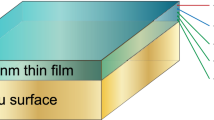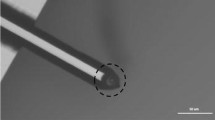Abstract
Understanding the mechanism of the bacterial cell adhesion to solid surfaces is of great medical and industrial importance. Bacterial adhesion to inert surfaces, such as a catheter, and other indwelling devices can form biofilm, consequently cause severe morbidity and often fatal infections. Initial bacterial adhesion to the material surfaces is a complicated process that is affected by various physicochemical properties of both bacterial cells and substratum surfaces. The surface properties of the cells were characterized by the sessile drop technique. Moreover, the interfacial free energy of Staphylococcus aureus adhesion to the supporting materials was determined. The results showed that S. aureus examined at different pH levels could be considered hydrophilic. We noted hat the electron-donor character of S. aureus was important at intermediate pH (pH 5, pH 7, and pH 9) and it decreased at both limits acidic and basic conditions. In addition, the adhesion of Staphylococcus aureus ATCC 25923 to the hydrophilic glass and hydrophobic indium tin oxide (ITO)-coated glass surfaces at different pH values (2, 3, 5, 7, 9 and 11) was investigated using atomic force microscopy (AFM) and image analysis was assessed with the Mathlab® program. The data analysis showed that cells (number of adhering cells to glass and ITO-coated glass surface) adhered strongly at acidic pH and weakly at alkaline pH. Also, S. aureus has the ability to attach to both hydrophobic and hydrophilic surfaces, but the adhesion was higher on hydrophobic surface.







Similar content being viewed by others
References
Arciola CR, Baldassarri L, Montanaro L (2001a) Presence of icaA and icaD genes and slime production in a collection of staphylococcal strains from catheter associated infections. J Clin Microbiol 39:2151–2156. doi:10.1128/JCM.39.6.2151-2156.2001
Arciola CR, Collamati S, Donati E, Montanaro L (2001b) A rapid PCR method for the detection of slime producing strains of Staphylococcus epidermidis and S. aureus in periprosthesis infections. Diagn Mol Pathol 10:130–137
Arciola CR, Campoccia D, Gamberini S, Cervellati M, Donati E, Montanaro L (2002) Detection of slime production by means of an optimised Congo red agar plate test based on a colourimetric scale in Staphylococcus epidermidis. Clinical isolates genotyped for ica locus. Biomaterials 23:4233–4239. doi:10.1016/S0142-9612(02)00171-0
Bayer ME, Sloyer JL (1990) The electrophoretic mobility of gram-negative and gram-positive bacteria: an electrokinetic analysis. J Gen Microbiol l136:867–874
Beck G, Puchelle E, Plotkowski C, Peslin R (1988) Effect of growth on surface charge and hydrophobicity of Staphylococcus aureus. Ann Inst Pasteur Microbiol 139:655–664. doi:10.1016/0769-2609(88)90070-1
Bellon-Fontaine MN, Rault J, Van Oss CJ (1996) Microbial adhesion to solvents: a novel method to determine the electron-donor/electron-acceptor or Lewis acid-base properties of microbial cells. Colloids Surf B Biointerfaces 71:147–153. doi:10.1016/0927-7765(96)01272-6
Briandet R, Meylheuc T, Maher C, Bellon-Fontaine MN (1999) Listeria monocytogenes Scott A: cell surface charge, hydrophobicity, and electron donor and acceptor characteristics under different environmental growth conditions. J Appl Environ Microbiol 65:5328–5333. doi:0099-2240/99/$04.0010
Busscher HJ, Weerkamp AH, van der Mei HC, van Pelt AWJ, de Jong HP, Arends J (1984) Measurement of the surface free energy of bacterial cell surfaces and its relevance for adhesion. Appl Environ Microbiol 48:980. doi:0099-2240/84/110980-04$02.00/0
Chaieb K, Chehab O, Zmantar T, Rouabhia M, Mahdouani K, Bakhrouf A (2007) In vitro effect of pH and ethanol on biofilm formation by clinical ica-positive Staphylococcus epidermidis strains. Ann Microbiol 7:31–437
Cramton SE, Gerke C, Schnell NF, Nichols WW, Götz F (1999) The intercellular adhesion (ica) locus is present in Staphylococcus aureus and is required for biofilm formation. Infect Immun 67:5427–5433. doi:0019-9567/99/$04.0010
El Ghmari A, Latrache H, Hamadi F, El Louali M, El Bouadili A, Hakkou A, Bourlioux P (2002) Influence of surface cell structures on physicochemical properties of Escherichia coli. New Microbiol 25:173–178
Freeman DJ, Falkiner FR, Keane CT (1989) New method for detecting slime production by coagulase negative staphylococci. J Clin Pathol 42:872–874
Gerin P, Bellon-Fontaine MN, Rouxhet PG (1995) Immobilisation of fungal spores by adhesion. Biotechnol Bioeng 47:677–687. doi:10.1002/bit.260470608
Götz F, Peters G (2000) Colonization of medical devices by coagulase-negative staphylococci. In: Waldvogel FA, Bisno AL (eds) Infections associated with indwelling medical devices. American Society for Microbiology Press, Washington, DC, pp 55–88
Gündogan N, Citak S, Turan E (2006) Slime production, DNAse activity and antibiotic resistance of Staphylococcus aureus isolated from raw milk, pasteurised milk and ice cream samples. Food Control 17:389–392. doi:10.1016/j.foodcont.2005.01.006
Hamadi F, Latrache H, Mabrrouki M, El Ghmari A, Outzourhit A, Ellouali M, Chtaini A (2005) Effect of pH on distribution and adhesion of Staphylococcus aureus to glass. J Adhes Sci Technol 19:73–85. doi:10.1163/1568561053066891
Herald PJ, Zottola EA (1988) Scanning electron microscopic examination of Yersinia enterocolitica attached to stainless steel at selected temperatures and pH values. J Food Prot 51:445–448. doi:10.1234/12345678
Herben PFG, Mozes N, Rouuxhet PG (1990) Variation of the surface properties of Bacillus licheniformis according to age, temperature, and aeration. Biochim Biophys Acta 1033:184–188. doi:10.1016/0304-4165(90)90010-T
Latrache H, Moses N, Pelletier C et al (1994) Chemical and physicochemical properties of Escherchia coli: Variations among three strains and influence of culture conditions. Colloid Surf B 2:47–56
Latrache H, Bouriloux P, Karroua M, Zahir H, Hakkou A (2000) Effects of subinhibitory concentration of Nitroxoline on the surface properties of Escherichia coli. Folia Microbiol 45:485–490
Ljunjh A, Wadstrom T (1984) Fimbriation in relation to hydrophobicity of bacteria in urinary tract infection. Eur J Clin Microbiol 3:568–570. doi:10.1007/BF02013626
Mabboux F, Ponsonnet L, Morrier JJ, jaffrezic N, Barsotti O (2004) Surface free energy and bacterial retention to saliva-coated dental implant materials—an in vitro study. Colloids Surf B Biointerfaces 39:199–205. doi:10.1016/j.colsurfb.2004.08.002
Mozes N (1995) In: Bellon-Fontaine MN, Fourniat J (eds) Adhésion des Micro-Organismes Aux Surfaces, Technique et Documentation. p 3
Pelletier C, Bouley C, Cayuela C, Bouttier S, Bourlioux P, Bellon-Fontaine MN (1997) Cell surface characteristics of Lactobacillus casei subsp. casei, Lactobacillus paracasei subsp paracasei, and Lactobacillus rhamnosus strains. Appl Environ Microbiol 63(5):1725–1731. doi:0099-2240/97/$04.0010
Rohde H, Knobloch JK, Horstkotte MA, Mack D (2001) Correlation of Staphylococcus aureus icaADBC genotype and biofilm expression phenotype. J Clin Microbiol 39:4595–4596. doi:10.1128/JCM.39.12.4595-4596.2001
Rose RK, Matthews SP, Hall RC (1997) Investigation of calcium-binding sites on the surfaces of selected gram-positive oral organisms. Arch Oral Biol 42(9):595–599. doi:10.1016/S0003-9969(97)00062-9
Rouxhet PG, Mozes N (1990) Physical chemistry of the interface between attached cell and their support. Wat Sci Tech 22:1–16
Van der Mei HC, Veris J, Busscher HJ (1993) Hydrophobic and electrostatic cell surface properties of thermophilic dairy streptococci. J Appl Environ Microbiol 59:4305–4312. doi:0099-2240/93/124305-08$02.00/0
Van Loosdrecht MCM, Lyklema J, Norde W, Schraa G, Zehnder AJB (1987) The role of bacterial cell wall hydrophobicity in adhesion. J Appl Environ Microbiol 53:1893–1897. doi:0099-2240/87/081893-05$02.00/0
Van Oss CJ (1993) Acid-base interfacial interactions in aqueous media. Colloid Surf A 78:1–49
Van Oss CJ, Good RJ, Chaudhury MJ (1986) The role of van der Waals forces and hydrogen bonds in hydrophobic interactions between biopolymers and low energy surfaces. Colloids Interfaces Sci 111:378. doi:10.1016/0021-9797(86)90041-X
Van Oss CJ, Chaudhury MK, Good RJ (1988) Interfacial lifshitz-van der Waals and polar interactions in macroscopic systems. Chem Rev 88:927–941. doi:0009-2665/88/0788-0927$06.50/0
Von Eiff C, Heilmann C, Peters G (1999) New aspects in the molecular basis of polymer-associated infections due to staphylococci. Eur J Clin Microbiol Infect Dis 18:843–846. doi:10.1007/s100960050417
Wang J, Huang N, Pan CJ, Kwok SCH, Yang P, Leng YX, Chen JY, Sun H, Wan GJ, Liu ZY, Chu PK (2004) Bacterial repelence from polyethylene terephthalate surface modified by acetylene plasma immersion ion implantation-deposition. Surf Coatings Technol 186:299–304
Wu W, Giese RF, Van Oss CJ (1994) Linkage between sigma-potential and electron donicity of charged polar surfaces. Implications for the mechanism of flocculation of particle suspensions with plurivalent counterions. Colloid Surf A 89:241–252. doi:10.1016/0927-7757(94)80122-3
Ziebuhr W, Krimmer V, Rachid S, Lossner I, Gotz F, Hacker J (1999) A novel mechanism of phase variation of virulence in Staphylococcus epidermidis: evidence for control of the polysaccharide intercellular adhesin synthesis by alternating insertion and excision of the insertion sequence element IS256. Mol Microbiol 32:345–356. doi:10.1046/j.1365-2958.1999.01353
Zmantar T, Chaieb K, Makni H, Miladi H, Ben Abdallah F, Mahdouani K, Bakhrouf A (2008) Detection by PCR of adhesins genes and slime production in clinical Staphylococcus aureus. J Basic Microbiol 48:308–314. doi:10.1002/jobm.200700289
Author information
Authors and Affiliations
Corresponding author
Additional information
The authors Tarek Zmantar and Fadhila Bettaieb contributed equally in this work.
Rights and permissions
About this article
Cite this article
Zmantar, T., Bettaieb, F., Chaieb, K. et al. Atomic force microscopy and hydrodynamic characterization of the adhesion of staphylococcus aureus to hydrophilic and hydrophobic substrata at different pH values. World J Microbiol Biotechnol 27, 887–896 (2011). https://doi.org/10.1007/s11274-010-0531-3
Received:
Accepted:
Published:
Issue Date:
DOI: https://doi.org/10.1007/s11274-010-0531-3




